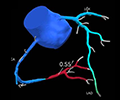September 2023 Br J Cardiol 2023;30:106–7 doi:10.5837/bjc.2023.028
Kerrick Hesse, Zaw Htet, Mickey Jachuck, Nicholas Jenkins
Abstract

Introduction
Undifferentiated chest pain places a significant burden on the UK National Health Service (NHS). Up to 50% of the general population experiences chest pain in their lifetime contributing to at least 1% of GP consultations and 5% of accident and emergency (A&E) attendances.1 Chest pain patients have a twofold higher mortality versus age-matched asymptomatic controls.1 One reason is undiagnosed obstructive coronary artery disease (CAD), which has effective treatments to prolong life and improve symptoms.1 The challenge is identifying the patients at greatest risk, providing a timely diagnosis and starting effective treatment.
T
|
Full text

September 2019 Br J Cardiol 2019;26:105–9 doi:10.5837/bjc.2019.029
Paul Brady, Andrew Kelion, Tom Hyde, Edward Barnes, Hazim Rahbi, Andy Beale, Steve Ramcharitar
Abstract

Introduction
In 2010, the UK’s National Institute for Health and Care Excellence (NICE) published a landmark guideline for the investigation of patients with chest pain of recent onset (CG95). This placed a major emphasis on determining the pre-test probability of coronary artery disease (CAD) and then using this information to select an appropriate imaging test, the exact choice depending to some extent on local expertise.1
In November 2016, NICE published an update of CG95, and made substantial changes to the guidelines. As well as eliminating the clinically derived pre-test probability as a means of directing further investigations, NICE
|
Full text

July 2018 Br J Cardiol 2018;25:107–9 doi:10.5837/bjc.2018.019
Saad Fyyaz, Alexandros Papachristidis, Jonathan Byrne, Khaled Alfakih
Abstract

Introduction
The National Institute for Health and Care Excellence (NICE) released an updated guideline on stable chest pain in 2016.1 It marked a radical departure from the 2010 NICE and European Society of Cardiology (ESC) guidelines.2 They recommended that the pre-test probability risk score should not be used as it over-estimated the likelihood of coronary artery disease (CAD) and that all patients with chest pain, typical or atypical, should be investigated with computed tomography (CT) coronary angiography (CTCA) in the first instance. Functional imaging tests were reserved for the assessment of patients with chest pain and known CAD,
|
Full text
April 2013 Br J Cardiol 2013;20:46 Online First
Dr Justin Williamson; Drs Toby Rogers, Jonathan Hill, and Khaled Alfakih
Abstract

Feasibility of using CTCA in patients with acute low-to-intermediate likelihood chest pain in a DGH
Dear Sirs,
I would like to make three points about this paper:1
1. The summary states “results suggest that it is feasible to use computed tomography coronary angiography (CTCA)…in place of exercise tolerance testing (ETT) at no extra cost”. The body of the article shows “CTCA had a higher cost compared with ETT. The overall cost per patient was £375 with CTCA vs. £309 with ETT, but this was not statistically significant (p=0.28)”. The lack of significance is attributable to the small size of the data-set, and it does not allow a co
|
Full text




